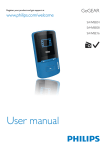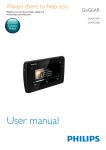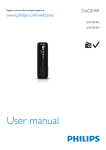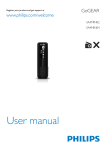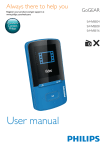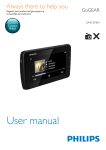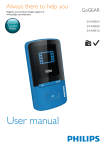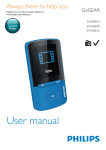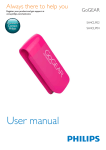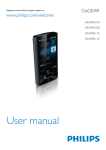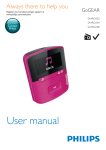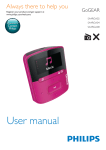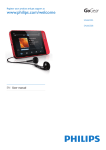Download Philips MP3 video player SA4TP404WF
Transcript
Register your product and get support at
GoGEAR
www.philips.com/welcome
SA4TP404
User manual
Contents
1 Important safety information
General maintenance
2 Your new player
What's in the box
Software loaded on the player
Files loaded on the player
Overview
Controls
Screens
Use the stand
3 Get started
Charge power
Switch the player on or off
Automatic standby and shut down
4 Build a media library on TAP4.3
Transfer from your PC media library
Use a Micro SD card
Play from the Micro SD card
storage to SD card
5 Music
Browse the music library
Browse by playlist
Play music
Select play options
Select sound options
Playlists
Create a playlist on the go
Play a playlist
Delete songs
6 Videos
Browse the video library
5
5
8
8
8
8
8
8
9
10
11
11
11
11
12
12
12
12
Browse by title
Play videos
Select play options
Select sound options
Select the brightness
Delete videos
16
16
16
16
16
16
7 Pictures
17
Browse the picture library
Browse by album
Play pictures
Select play options
View pictures
Set a picture as wallpaper
Favorite pictures
Add pictures to Favorites
Remove pictures from Favorites
Delete pictures
17
17
17
17
17
18
18
18
18
19
8 FM radio
20
Tune in to radio stations
Auto tune
Manual tune
Store preset stations
20
20
20
21
9 Recordings
13
14
14
14
14
14
14
15
15
15
15
22
Make recordings
Record voices
Play recordings
Delete recordings
22
22
22
22
10 Text reader
23
11 Folder view
24
12 SD Card
25
16
16
EN
3
13 Settings
26
Set power saving mode
Sleep timer
Display settings
Touch panel calibration
Language
Information
Format device
Factory settings
26
26
26
26
26
26
27
27
14 Sync with PC media library
through Philips Songbird
28
Install Philips Songbird
Set the watch folder
Create playlists in Philips Songbird
Create a playlist
Generate LikeMusic playlists
Save the play queue as a playlist
!"
#"$
Edit metadata
Get album artwork
$
Sync the player with Philips Songbird
Select auto or manual sync
Auto sync
Manual sync
28
28
30
30
30
31
32
32
33
33
34
34
Philips Device Manager
35
16 Troubleshooting
36
17 Technical data
37
#%
% #%
#%
%
System requirements
4
EN
&
&
&
38
Need help?
Please visit
www.philips.com/welcome
where you can access a full set of supporting
materials such as the user manual, the latest
software updates, and answers to frequently
asked questions.
1 Important safety
information
General maintenance
The translation of this document is for
reference only.
In the event of any inconsistency between the
English version and the translated version, the
English version shall prevail.
Caution
( To avoid damage or malfunction:
( Do not expose the product to excessive heat caused
by heating equipment or direct sunlight.
( Do not drop the product or allow objects to fall on
your player.
( Do not allow the product to be submerged in
(
(
(
(
water. Do not expose headphone socket or battery
compartment to water, as water entering the set may
cause major damage.
Active mobile phones in the vicinity may cause
interference.
)* % % + ;%
% "
% <
% + responsible for any loss of data if the product becomes
damaged or not readable / legible.
!"
=
> > +? % % <
the supplied music software to avoid problems.
Do not use any cleaning agents containing alcohol,
ammonia, benzene, or abrasives as these may harm the
product.
About operating and storage temperatures
( Operate in a place where temperature is
always between 0 and 35ºC (32 to 95ºF)
( Store in a place where temperature is
always between 20 and 45ºC ( 4 to
113ºF).
( Battery life may be shortened in low
temperature conditions.
Replacement parts/accessories:
Visit www.philips.com/support to order
replacement parts/accessories.
Hearing Safety
Listen at a moderate volume:
Using headphones at a high volume can impair
your hearing. This product can produce sounds
in decibel ranges that may cause hearing loss for
a normal person, even for exposure less than
a minute. The higher decibel ranges are offered
for those that may have already experienced
some hearing loss.
Sound can be deceiving. Over time your hearing
'comfort level' adapts to higher volumes of
sound. So after prolonged listening, what sounds
'normal' can actually be loud and harmful to
your hearing. To guard against this, set your
volume to a safe level before your hearing
adapts and leave it there.
To establish a safe volume level:
Set your volume control at a low setting.
Slowly increase the sound until you can hear it
comfortably and clearly, without distortion.
Listen for reasonable periods of time:
Prolonged exposure to sound, even at normally
'safe' levels, can also cause hearing loss.
Be sure to use your equipment reasonably and
take appropriate breaks.
Be sure to observe the following guidelines
when using your headphones.
Listen at reasonable volumes for reasonable
periods of time.
Be careful not to adjust the volume as your
hearing adapts.
Do not turn up the volume so high that you
can’t hear what’s around you.
You should use caution or temporarily
discontinue use in potentially hazardous
situations.
Do not use headphones while operating a
motorized vehicle, cycling, skateboarding, etc.; it
K " areas.
EN
5
! %K
$ manufacturer may void user's authority to
operate the product.
Copyright information
All other brands and product names are
trademarks of their respective companies or
organizations.
Unauthorized duplication of any recordings
whether downloaded from the Internet or
made from audio CDs is a violation of copyright
laws and international treaties.
The making of unauthorized copies of copy
protected material, including computer
"> > $ %
recordings, may be an infringement of
copyrights and constitute a criminal offense.
This equipment should not be used for such
purposes.
The Windows Media and the Windows logo are
registered trademarks of Microsoft Corporation
in the United States and/or other countries.
Be responsible! Respect copyrights.
state that no further copies shall be made.
Video streams may include copy protection
technology that prohibits further copying. For
such situations the recording function will not
<* % < $
< "
+
Data logging
Philips is committed to improving the quality
of your product and enhancing the Philips user
+N %
%"
this device, this device logs some info / data to
the non volatile memory region of the device.
These data are used to identify and detect
any failures or problems you as a user may
experience while using the device. The data
stored, for example, will be the duration of
playback in music mode, duration of playback
in turner mode, how many times battery low
was encountered, etc. The data stored do not
reveal the content or media used on the device
or the source of downloads. The data stored on
the device are retrieved and used ONLY if the
user returns the device to the Philips service
center and ONLY to simplify error detection
and prevention. The data stored shall be made
$
%
%
X Z%
+
Monkey's Audio decoder
Philips respects the intellectual property of
others, and we ask our users to do the same.
Multimedia content on the internet may have
been created and/or distributed without the
original copyright owner's authorization.
Copying or distributing unauthorized content
may violate copyright laws in various countries
including yours.
Compliance with copyright laws remains your
responsibility.
The recording and transfer to the portable
player of video streams downloaded to your
computer is intended only for use with public
domain or properly licensed content. You
may only use such content for your private,
non commercial use and shall respect eventual
copyright instructions provided by the copyright
owner of the work. Such instruction may
6
EN
a The Monkey's Audio SDK and source
code can be freely used to add
APE format playback, encoding, or
tagging support to any product, free
or commercial. Use of the code for
proprietary efforts that don't support
consent of the author.
b Monkey's Audio source can be included
in GPL and open source software,
although Monkey's Audio itself will
not be subjected to external licensing
restrictions.
c Code changes and improvements must be
contributed back to the Monkey's Audio
project free from restrictions or royalties,
unless exempted by express written
consent of the author.
d Any source code, ideas, or libraries used
must be plainly acknowledged in the
software using the code.
e Although the software has been tested
thoroughly, the author is in no way
responsible for damages due to bugs or
misuse.
If you do not completely agree with all of the
previous stipulations, you must cease using this
source code and remove it from your storage
device.
THE FOUNDATION OR CONTRIBUTORS
BE LIABLE FOR ANY DIRECT, INDIRECT,
INCIDENTAL, SPECIAL, EXEMPLARY, OR
CONSEQUENTIAL DAMAGES (INCLUDING,
BUT NOT LIMITED TO, PROCUREMENT OF
SUBSTITUTE GOODS OR SERVICES; LOSS
OF USE, DATA, OR PROFITS; OR BUSINESS
INTERRUPTION) HOWEVER CAUSED
AND ON ANY THEORY OF LIABILITY,
WHETHER IN CONTRACT, STRICT LIABILITY,
OR TORT (INCLUDING NEGLIGENCE OR
OTHERWISE) ARISING IN ANY WAY OUT
OF THE USE OF THIS SOFTWARE, EVEN IF
ADVISED OF THE POSSIBILITY OF SUCH
DAMAGE.
FLAC decoder
Copyright (C) 2000,2001,2002,2003,2004,2005,
2006,2007,2008,2009 Josh Coalson
Redistribution and use in source and binary
> < <% > permitted provided that the following
conditions are met:
( Redistributions of source code must retain
the above copyright notice, this list of
conditions and the following disclaimer.
( Redistributions in binary form must
reproduce the above copyright notice,
this list of conditions and the following
disclaimer in the documentation and/
or other materials provided with the
distribution.
( Neither the name of the Xiph.
org Foundation nor the names of its
contributors may be used to endorse
or promote products derived from this
<
<% <
permission.
THIS SOFTWARE IS PROVIDED BY
THE COPYRIGHT HOLDERS AND
CONTRIBUTORS "AS IS" AND ANY EXPRESS
OR IMPLIED WARRANTIES, INCLUDING,
BUT NOT LIMITED TO, THE IMPLIED
WARRANTIES OF MERCHANTABILITY AND
FITNESS FOR A PARTICULAR PURPOSE
ARE DISCLAIMED. IN NO EVENT SHALL
EN
7
2 Your new player
What's in the box
Make sure that you have received the following
items:
Player
Software loaded on the player
TAP4.3 comes with the following software:
( Philips Songbird (helps you manage your
media library on a PC and the player)
( Philips Device Manager (helps you get
<
%
?
To getPhilips SongbirdandPhilips Device
Manageronline,
( On your PC, download from
www. philips.com/Songbird or
www.philips.com/support.
Files loaded on the player
Earphones
N
<" TAP4.3:
( User manual
( Frequently asked questions
Overview
USB cable
Controls
h
Quick start guide
a
g
f
b
Ph ips GoGear a dio p ay r
e
d
c
Quick start guide
Safety and Warranty sheet
Safety and Warranty
1
2
/
,
Be o e u i g our set
Che k o t det i s ns de th s book et
3
Note
( The images serve as reference only. Philips reserves the
right to change color/design without notice.
8
EN
4
5
MIC
Press and hold: switch on/off the
device
Press: lock/unlock the screen
Press: increase/decrease the
volume.
Press and hold: increase/decrease
fast.
USB connector for power
charging and data transfer
Microphone
3.5 mm headphone connector
6
7
8
RESET
Press the hole by using the tip of
a ball pen when the screen does
not respond to the pressing of
keys
MICRO Slot for Micro SD card
SD
Speaker
Screens
Home screen
Menu
Mode
Music
Video
Pictures
FM radio
Text
reader
Settings
To
% watch videos
view pictures
tune in to the FM radio
=+? customize the settings of
TAP4.3
Micro SD < card
that you store on the
Micro SD card
Recordings create or listen to
recordings
Folder
< view
that you store on the
internal storage of the
player
Navigate on the screens
On the screens, tap the icons to access menus
or options. If necessary, tap the screen to display
the icons.
To access functional menus or options,
( Tap the icon or option.
Lock and unlock the screen
Lock the screen of TAP4.3. You can lock
all the touch controls on the screen (the
volume controls still function). Thus, undesired
operations are prevented.
Auto lock
After a time duration, the screen dims and is
locked automatically. To set the time duration,
go to > [Display settings] >
[Screen off timer].
To lock the screen manually
( Press / .
To unlock the screen
( Press / .
Select the wallpaper
To select wallpaper for the Home screen,
( From the Home screen, go to >
[Display settings] > [Wallpaper]. Select a
theme.
To set the custom wallpaper,
( Go to . Play a picture and set the
wallpaper (see 'Set a picture as wallpaper'
on page 18).
To switch from a theme to the last custom
wallpaper,
( In > [Display settings] > [Wallpaper],
select [Custom].
To go back to previous screens,
( Tap
repeatedly.
To return to the Home screen,
( Tap .
EN
9
Use the stand
Use the stand at the back of the player. You can
position the player in a different way.
1
2
At the back of the player, lift the stand.
10
EN
Push the stand to its full width.
To conserve battery power and increase the
play time, do the following on TAP4.3:
( Set the backlight timer to a low value (go
to > [Display settings] >
[Screen off timer]).
3 Get started
Charge power
TAP4.3 has a built in battery that can be
charged through the USB connector of a
computer.
Connect TAP4.3 to a PC by using the USB
cable.
Switch the player on or off
Press and hold
or off.
until the player is switched on
Automatic standby and shut-down
The player has an automatic standby and shut
down feature that can save battery power.
If in idle mode (no play, no button is pressed)
for a certain time duration, the player switches
off automatically.
Note
( When you connect TAP4.3 to a computer, you are
(
$
{ | [Charge & transfer] or
[Charge & play]. If no option is selected, [Charge &
transfer] applies.
To play the TAP4.3 when you charge power, select
[Charge & play].
"
( From the Home screen, go to
[Set power saving mode…].
>
Battery level indication
The display indicates the approximate levels of
the battery status as follows:
100%
75%
50%
25%
0%
» ~ {" $
battery is low. The player saves all settings
and switches off within 60 seconds.
Note
( Rechargeable batteries have a limited number of charge
(
cycles. Battery life and number of charge cycles vary by
use and settings.
The charging animation stops and the
icon is
displayed when the charging process is completed.
EN
11
4 Build a media
library on
TAP4.3
Use a Micro SD card
Insert a Micro SD card (up to 32 GB) into the
TAP4.3. You can expand the memory size of
TAP4.3.
Build a media library on TAP4.3 before you play
from the player. To build such a media library,
you can
( transfer your PC media library to the
player;
( use a micro SD card (up to 32 GB) as
media library.
Transfer from your PC media
library
You can transfer your PC media library to
TAP4.3 in the following ways:
( Sync through Philips Songbird (see 'Sync
with PC media library through Philips
Songbird' on page 28);
With the media management software,
you can create playlists, or edit your media
collection by metadata or ID3 tag.
( " <
Explorer.
By doing so, you can organize your media
$ +
#
Explorer,
1
2
Connect TAP4.3 to a PC.
3
> " TAP4.3.
( ~
> " from the PC to TAP4.3.
12
EN
On the PC, under My Computer or
Computer,
( select TAP4.3> +
1
2
3
Push the cover of Micro SD card slot.
Drag to open the cover.
Insert the SD card into the slot until it is
fully inserted.
Play from the Micro SD card
(
Under , , or on the player, you can
%
the Micro SD card.
Alternatively,
( From the Home screen, tap . Select and
Micro SD card.
$%( storage to SD card
1
2
From the Home screen, go to .
3
4
Tap the checkbox next to options.
> Select [Copy] or [Move].
.
Tap [Copy [X] items to SD card] or
[Move [X] items to SD card] ([X] denotes
the number of selected songs).
» You copy or move selected items to
the SD card.
EN
13
5 Music
Select play options
On the play screen, tap icons to select play
options:
Go to to play music from the media library
on the player.
/
Tap to switch to the library or
play screen.
Tap to pause/resume play.
Tap to skip songs;
Hold to search within current
song.
Tap once or more to select repeat
options:
Repeat all: Tap to repeat all songs
in current folder.
Repeat one: Tap to repeat current
song.
Tap to play all songs in current
folder in random order.
/
Browse the music library
/
In > % "K
$ =
information). You can browse the music library
by song information.
1
2
Tap to select a library view:
( Tap , , or to sort songs by song
title, album, or artist.
» The music library is sorted by the
song information.
%> <
% "
% <
to browse through the list of options.
Browse by playlist
Tap and select the library view of . You can
|
( playlists on the go that you create on the
player.
To switch between the play screen and library
screen
( Tap to go to the Home screen;
( To return to the play screen, tap on the
Home screen.
Select sound options
(
On the play screen, tap
[FullSound]
)*
+
[Volume
limit]
Play music
1
2
% $> $<
%+
14
EN
Tap a song.
» Play starts from current song.
» The play screen is displayed.
to select options:
Restore the sonic details that
music compression loses (such
as MP3, WMA).
% " +
Set a maximum volume level for
the device. In this way, you can
always keep the volume within
a level safe enough to your
hearing.
Tap the volume bar to set the
maximum level.
Note
( Equalizer is deactivated when you select FullSound.
Playlists
With a playlist, you can access a list of songs
from different artists or albums.
Create a playlist-on-the-go
On TAP4.3> % the go.
Create a playlist on the go
1
2
Tap
and select the library view of .
Tap and select [Create new 'Playlist on
the go'].
» A playlist on the go is created.
Add songs to a playlist
1
2
3
Play a song.
On the play screen,
( tap and select [Add to playlist].
» A list of playlists is displayed.
N + prompted.
» Current song is added to the playlist.
To delete selected songs,
1
Tap to select a library view: , , or .
» The music library is sorted by the song
information in alphabetical order.
2
3
4
Tap
and select [Delete].
Tap the checkbox next to songs.
Tap [Delete [X] items] ([X] denotes the
number of selected songs).
» Selected songs are deleted.
To delete current song on the play screen,
( Tap and select [Delete].
» Current song is deleted.
To delete selected playlists,
1
2
Tap
3
4
Tap the check box to select playlists.
to select the library view of .
Tap and select [Delete a playlist].
» A list of playlists is displayed.
+
» Selected playlists are deleted.
Play a playlist
1
Tap and select the library view of
[Playlists].
» A list of playlists is displayed.
2
Tap to select a playlist and song.
» The playlist starts playing from current
song.
Delete songs
You can delete songs in the following ways:
( Delete selected songs;
( Delete current song;
( Delete selected playlists.
EN
15
6 Videos
Search for a particular section
Go to to play videos from the media library
on the player.
Browse the video library
(
$> "K
$
=
?+
Browse by title
With columns for video artwork, title and total
play time, the video library of TAP4.3 allows
% $<
$% quickly.
1
Tap to select the library view.
» The video library is sorted by title.
2
On the play screen, tap on the progress
bar.
» The video play skips to the selected
position.
Switch to the Home screen or previous
screen
( Tap to go to the Home screen.
( Tap
to go to the previous screen.
Select sound options
(
%> <
% "
% <
to browse through the list of options.
On the play screen, tap to select
Surround for movies (surround sound for
movie play).
Select the brightness
Play videos
1
2
(
$> $<
+
Tap a video.
» Play starts from current video.
» The play screen is displayed.
Select play options
On the play screen, tap icons to select play
options:
( If necessary, tap on the screen to display
the icons.
/
Tap to switch to the library or
play screen.
Tap to pause/resume play.
Tap to skip titles.
Tap to switch between the full
screen and normal view.
/
/
/
16
EN
On the play screen, tap to select
[Brightness]. Drag the slider to select an
option.
Delete videos
1
2
3
4
Tap
to select the library view.
Tap
and select [Delete].
Tap the check box to select options.
+
» Selected items are deleted.
Alternatively,
( Play a video. Tap and select [Delete].
» Current video is deleted.
7 Pictures
Select play options
Go to to play pictures from the media library
on the player.
Browse the picture library
%
$> %
"K
$ $% +
Browse by album
1
2
Tap
On the play screen, tap icons to select play
options:
( If necessary, tap on the screen to display
the icons.
to select the library view.
/
Tap to select an album or folder.
» Pictures in the folder are shown as
thumbnails.
/
3
#<
% "
% < $<
through the thumbnails.
/
4
Tap a thumbnail to play the picture.
Play pictures
1
In , tap to play a selected picture.
» The play screen is displayed.
2
Swipe left/ right to select a picture.
Tap to switch to the library or
play screen.
Tap to start/pause/resume
slideshow play.
Tap to skip pictures.
Select slideshow settings
( On the play screen, press and select
[Slideshow settings]:
[Slideshow effect]: Set the transition mode
between two slides.
[Set Time per slide]: Set the time interval
before one slide switches to another.
[Repeat]: Play pictures in current folder
repeatedly.
);<
+: Play pictures in current folder in
random order.
View pictures
Zoom pictures
To play pictures one by one
( Tap .
Alternatively,
( Tap and select [Start slideshow].
1
On the play screen, tap on
zoom control bar.
2
Drag the track ball to zoom in/ out the
picture.
3
In an enlarged picture, swipe to pan
through the picture.
4
Tap on the screen to return to normal size.
to show the
EN
17
a
b
Tip
( You can also set the wallpaper in
> [Display
settings] > [Wallpaper].
Favorite pictures
c
With the [Favorites pictures] folder, you can
access your favorite pictures from different
albums.
To rotate the picture,
( Tap to rotate the picture clockwise by 90
degrees.
Add pictures to Favorites
Add selected pictures or albums to Favorites
1
2
Tap
3
N *$ + as prompted.
» Selected albums and pictures are
added to [Favorites pictures].
Set a picture as wallpaper
To set a picture as the wallpaper of Home
screen,
1
2
Tap to play the selected picture.
3
To select part of the picture:
( drag the track ball to zoom in the
picture;
( swipe to pan through the enlarged
picture.
On the play screen, press
[Set as wallpaper].
and select
to select the library view.
On the library screen,
( tap and select [Add to 'Favorites'].
» Checkboxes are displayed next to
each album and each picture under
the album.
Add current picture to Favorites
1
2
Play a picture.
On the play screen, tap and select [Add
to 'Favorites'].
» Current picture is added to [Favorites
pictures].
Remove pictures from Favorites
Remove selected pictures from Favorites
1
2
4
Tap [Set as wallpaper].
18
EN
Tap
to select the library view.
On the library screen,
( tap and select [Remove from
'Favorites' folder].
» Checkboxes are displayed next to
each picture under the folder.
3
N *$ + as prompted.
» Selected pictures are removed from
the Favorites folder.
Remove current picture from Favorites
1
2
Play a picture.
On the play screen, tap and select
[Remove from 'Favorites' folder].
» Current picture is removed from the
Favorites folder.
Delete pictures
You can delete pictures in the following ways:
( Delete pictures by album/ folder;
( Delete selected pictures.
To delete selected albums, folders, or pictures,
1
2
3
Tap
to select the library view.
Tap
and select [Delete picture].
4
Tap [Delete [X] items] ([X] denotes the
number of selected items).
» Selected items are deleted.
Tap the checkbox next to options:
( Select an album to delete all the
pictures under the album;
( Select pictures that you want to delete.
To delete current picture on the play screen,
1
2
Tap
and select [Delete picture].
+
» Current picture is deleted.
Tip
( When you delete albums or pictures, you also remove
them from the [Favorites pictures] folder.
EN
19
8 FM radio
Note
( Plug in the supplied earphones when you tune in to
radio stations. The earphones double as antenna. For
better reception, move the earphone cable in different
directions.
Tune in to radio stations
Tip
( When you move to a new place (such as a new city or
country), restart auto tune for better reception.
Auto tune
1
From the Home screen, go to .
» The last played station starts to play.
2
To select a preset station, tap to select
the library view of presets. Tap to play a
preset station.
Manual tune
Use Manual tune to search for a frequency.
1
From the Home screen, go to .
» The last played station starts to play.
2
On the radio play screen, search for a
frequency:
( Swipe left/ right on the frequency bar.
3
To mute/ unmute the sound, tap
» The play screen is displayed.
To restart auto tune,
1
On the play screen, press , and select
[Auto tune].
» Up to 20 available stations are stored
to replace the old presets.
2
To mute/ unmute the sound, tap
20
EN
/
.
/
.
Store preset stations
On TAP4.3, you can store up to 20 preset
stations.
1
2
3
Tune in to a radio station.
On the radio play screen, press and
select [Save to preset].
» The list of presets is displayed
N + as prompted.
» Current station is saved to the selected
location.
EN
21
9 Recordings
On the play screen, tap icons to select play
options:
/
Make recordings
/
/
/
With TAP4.3, you can record:
( voice through the built in microphone.
Tap to switch to the library, play,
or recording screen.
Tap to pause/resume play.
N *
< %
+
Record voices
1
2
3
From the Home screen, go to .
4
Do the following to start, pause, or stop
recording.
Tap
to switch to the recording screen.
Make sure that the microphone is close to
the sound source.
/
Tap to start, pause, or resume
recording.
Tap to stop recording.
» Recordings are saved to >
Recordings > Voice. (Filename format:
REC 00000000 XXX.MP3, where
XXX is the recording number that is
generated automatically.)
5
Tap
to switch to the recordings library.
Play recordings
1
2
From the Home screen, go to .
Tap to switch to the library screen.
» In the recordings library, existing
recordings are displayed.
3
Tap a recording to start play.
» The play screen is displayed.
22
EN
Delete recordings
1
2
In , tap
3
4
Tap the checkbox to select options.
to switch to the library screen.
On the list of recordings,
( Tap and select [Delete].
+
» Selected items are deleted.
Alternatively,
1
2
Play a recording.
On the play screen, tap
[Delete].
and select
10 Text reader
Go to =+? library on the player.
=
> 1
Tap to select the library view.
» N
+
2
#<
% "
%< $<
through the list of options. Tap an option to
start play.
3
#<
% "
"
% pages.
*
"
( On the play screen, tap to select an
option. If necessary, tap to go to the play
screen.
To add a bookmark,
( Tap at the corner of the page.
» Current page is folded at the corner.
(
N $**> " % "
on the corner.
To go to the bookmarked section,
( On the play screen, tap and select
[Go to bookmark]. Select an option.
@
> 1
2
3
4
Tap
to select the library view.
Tap
and select [Delete].
Tap the check box to select options.
+
» Selected items are deleted.
EN
23
11 Folder view
Go to < internal storage of the player.
%(
to the SD card,
( > ,
and select options.
24
EN
12 SD Card
Go to < %
store on the Micro SD card.
EN
25
13 Settings
From the Home screen, go to to select your
settings.
( Tap an option to select it;
( Tap
to go to the previous screen.
Touch panel calibration
On TAP4.3, you tap to select an option. With
the touch screen calibrated, your taps can be
precisely positioned on the display screen.
1
Tap [Touch panel calibration] to start
calibration.
2
Follow onscreen instructions to complete
calibration.
Set power-saving mode
If in idle mode (no play, no button is pressed)
for a certain time duration, the player switches
off automatically.
( In [Set power saving mode…], tap to
select an option.
» After the selected time duration, the
device is switched off automatically.
Language
In [Language], select a language for the player.
Information
In [Information], learn the following information
about the device:
Sleep timer
During play or in idle mode, the TAP4.3 can
switch off automatically after a certain time
duration.
( In [Sleep timer], tap to select an option.
» After the selected time duration, the
device is switched off automatically.
Display settings
In [Display settings], select your display options:
[Brightness]
[Screen off
timer]
[Wallpaper]
26
EN
Drag the slider to select the
display brightness.
After the selected time
duration, the screen turns off
automatically. To save battery
power, select a low value.
Select a theme. Or, select
[Custom] to switch to the
custom wallpaper that you set
in
[Capacity:]
[Free
space:]
[SD card
capacity:]
[SD card
free
space:]
[Firmware
version:]
[Model:]
[Support
site:]
memory size
space available
memory size of the SD card that
is inserted into the player
space available on the SD card
that is inserted into the player
%
<
+ *
<
<
%" <
support website.
full product name. Check the full
product name when updating
<
%
website.
web site that provides support
for the device
Format device
Format the TAP4.3. You remove all the data that
are stored on the player.
( Tap [Format device], and select [Yes] as
prompted.
Factory settings
In [Factory settings], restore the player to
factory settings. Files transferred to the player
are retained.
EN
27
14 Sync with PC
media library
through Philips
Songbird
With Philips Songbird, you can do the following:
( Manage your music collection on a PC;
( Sync TAP4.3 with your PC music library;
( Register TAP4.3 on www.philips.com/
welcome.
Install Philips Songbird
1
2
Connect TAP4.3 to a PC.
3
Right click on the Philips GoGear TAP4.3
icon. Select Download Philips Songbird.
( Alternatively, click the Philips GoGear
TAP4.3 icon. Double click the setup.
exe.
4
Follow the onscreen instructions to
complete the installation.
On the PC, select My Computer
(Windows XP / Windows 2000) /
Computer (Windows Vista / Windows 7).
Note
( The installation requires you to agree to the license
terms.
28
EN
$
PC
Set the watch folder
Create a central folder
% % % to your library when you copy them to a folder.
Creating a central folder is recommended. In
Philips Songbird, set the central folder as the
watch folder. Each time you launch Philips
Songbird, songs are added to/ removed from
Philips Songbird as they are on the central folder.
On the PC, create a central folder to save all
% > > |#"$ +
First-time launch
N
% % Philips Songbird on
a PC, do the following as prompted to import
" Philips Songbird:
( Select the iTunes media folder to import
an existing iTunes library;
( Select the central folder to search and
" % +
» The central folder is set as the watch
folder of Philips Songbird.
Set iTunes media folder
1
2
Select Tools > Options.
1
On Philips Songbird, go to Tools >
Options...
2
Select Media Importer, and then the
iTunes Importer tab.
3
In Watch Folders, tick the check box as
shown.
3
4
Verify your library location and options.
4
Click Browse, and select the central folder
=
+"+|#"$ ? < +
» In Philips Songbird> added or removed as they are in the
central music folder.
Click the Import Library button next to
the library location.
» The software imports the iTunes
library into Philips Songbird.
Set the watch folder
In Philips Songbird, set the watch folder as
follows:
In Options, select Media Importer. Then,
select the Watch Folders tab.
J J In Philips Songbird,
( go to File > Import Media to select
folders on the PC.
» !
%
Library.
(
or, go to File > Import a playlist to select
playlists on the PC.
» !
%
Playlists.
EN
29
2
To add the songs to a playlist:
( Right click on the songs, and select
Add to Playlist;
( Select a playlist;
» The songs are added to the playlist.
(
Create playlists in Philips
Songbird
With a playlist, you can manage and sync your
songs as needed.
To create a playlist, select New Playlist.
» A new playlist is created for the
songs.
» Under Playlists, name the playlist
as needed.
Alternatively,
Create a playlist. Add selected songs to the
playlist.
Create a playlist
Select songs that you want to play. Add the
songs to a playlist.
1
Under Playlists, click to create a playlist.
» A new playlist is created.
2
3
Name the new playlist as desired.
" +
Tip
( N " %
> down the Ctrl button when you click on selections.
Generate LikeMusic playlists
1
In Library > Music, select songs.
( To select multiple songs, hold down
the Ctrl button when you click songs.
30
EN
Based on the LikeMusic analysis, a playlist can
be generated from a seed song.
LikeMusic analyzes songs in your library and,
based on their music characteristics, creates
relationships between them. These relationships
help LikeMusic to create playlists of songs that
sound great together.
When you import songs into the music library
of Philips Songbird, the LikeMusicanalysis starts.
For the song that completes the analysis, the
LikeMusic icon lights up; For the song that
cannot complete the analysis, the icon remains
gray.
Set the maximum number of songs
(
Select a seed song
Make sure that the seed song has completed
the LikeMusic analysis.
( In Library > Music, double click the blue
LikeMusic icon of the song;
Alternatively,
Select a number in the drop down list.
Save the LikeMusic playlist
( Click Save as playlist in the LikeMusic page.
» The LikeMusic playlist is saved under
Playlists.
;
% %
Create a play queue
( Drag and drop songs or playlists to the
Play Queue pane.
(
In Library > Music, right click on a song
and select Run LikeMusic with.
» A LikeMusic playlist is displayed in the
LikeMusic page.
Save the play queue as a playlist
1
Click Save.
» The play queue is saved as a playlist
under Playlists.
EN
31
2
Under Playlists, name the playlist as
needed.
% ( To add songs to the top, right click on the
options and select Queue Next;
( To add songs to the end, right click on the
options and select Queue Last.
1
In Library > Music or Videos, select a
+
2
" * View
Metadata.
» A metadata table appears for you to
edit the information.
Get album artwork
Artwork is sometimes available for music
downloads. With Philips Songbird, you can
insert artwork for songs.
After you sync the songs to some players, you
can browse the media library by artwork.
Songbird
(
On Philips Songbird, select Tools > Get
Artwork.
» Artwork is fetched for all titles in the
library.
(
Right click on selected titles, and select Get
Artwork.
» Artwork is fetched for all selected
titles.
Edit metadata
) " =
"?> % automatically by song title, artist, album, and
other information.
~
% > %
can browse the media library by metadata.
32
EN
=
\%
1
2
" * + #
Remove.
+
» N
library and from all playlists. (By default,
>
+
N
"
location on the computer or computer
network.)
Select auto or manual sync
N
% Philips
Songbird, select auto sync as prompted. The
player sync with Philips Songbird automatically.
If you didn't select auto sync, you switch on the
manual sync.
To select auto or manual sync,
Tip
( N %
> < Ctrl button
when you click on selections.
( N %
%
> < Shift
$% <
% * +
Sync the player with Philips
Songbird
1
2
On the PC, launch Philips Songbird.
Connect the player to the PC by using a
USB cable.
» On Philips Songbird, the player is
displayed when it is recognized by the
PC.
1
2
3
Select the player under Devices.
Select Manual or Auto.
N > * Apply.
EN
33
Auto sync
Manual sync
(
To manually transfer selected playlists,
(
If you have selected auto sync, auto sync
starts automatically when you connect the
player to a PC;
Alternatively, select the player under
Devices, and click Sync.
To select auto sync settings,
1
2
Select playlists.
Drag and drop the playlists to TAP4.3.
% "
1
2
Select the player under Devices.
3
Click to select an option.
On the pop up window, click the Music or
Videos tab.
1
On the Content pane, right click on a
+
2
Select Add to Device > TAP4.3.
» #
TAP4.3.
Tip
( N %
> < Ctrl button when you click on selections.
34
EN
15 Update the
firmware
through Philips
Device Manager
Install Philips Device Manager
1
2
3
4
Connect TAP4.3 to a PC.
On the PC, select My Computer
(Windows XP / Windows 2000) /
Computer (Windows Vista / Windows 7).
4
N * <
%
>
a Close the dialog box of Philips Device
Manager.
Right click on the Philips GoGear TAP4.3
icon. Select Install Philips Device Manager.
( Alternatively, click the Philips GoGear
TAP4.3 icon. Double click the installer.
exe.
b At the base of the PC screen, right
click and select Check for updates.
Follow the onscreen instructions to
complete the installation of the software.
Note
( The installation requires you to agree to the license
terms.
$
^ 1
Make sure that you have connected your
PC to the Internet.
2
Launch Philips Device Manager.
» A dialog box is displayed.
3
Connect TAP4.3 to your PC.
» When the device is connected,
"SA4TP4XX" is displayed on the text
box.
» % %
<
of the device.
» Philips SA4TP4XX Device
Manager checks for updates from
the Internet.
1
<
%
$
>
follow the onscreen instructions to
< <
+
2
Disconnect TAP4.3 from the PC.
» TAP4.3 <
updated and is ready for use again,
EN
35
16 Troubleshooting
If TAP4.3 is not working properly or the display
freezes, you can reset it without losing data:
How do I reset TAP4.3?
_
Insert a pen tip or other object into the
reset hole on TAP4.3. Hold until the player
shuts down.
_
If the reset option is unsuccessful, recover
TAP4.3 through Philips Device Manager:
1
On your PC, launch Philips Device
Manager.
2
Enter the recovery mode:
a Switch off TAP4.3.
b Press and hold the volume button ,
and then, connect TAP4.3 to your PC.
c Keep holding the button until Philips
@
*
`qz
and enters the recovery mode.
3
Start the recovery process:
a On Philips Device Manager, click the
Repair button. Follow the onscreen
instructions to complete the recovery
process.
b When the recovery is completed,
disconnect TAP4.3 from your PC.
4
Restart TAP4.3.
36
EN
17 Technical data
Media transfer³
( Songbird (sync)
( Windows Explorer (drag and drop)
Power
( Power supply: 1020 mAh Li ion polymer
internal rechargeable battery
( Play time¹
Music: up to 20 hours
Video: up to 4 hours
Radio: up to 25 hours
Display
( Touch sensitive color LCD
( 480 x 272 pixels
( 262 k colors
Software
( Philips Songbird: To transfer³ media
( Philips Device Manager: To update the
<
Connectivity
( Headphone 3.5 mm
( USB 2.0 High speed
Sound
Headphone:
( Channel separation: >35 dB
( Frequency Response: 45 Hz 16 kHz
( Output power (RMS): 2 x 10 mW
( Signal to noise ratio: > 80 dB
Audio playback
( MP3 bit rates: 8 320 kps and VBR
( MP3 sample rates: 8, 11.025, 16, 22.050, 24,
32, 44.1, 48 kHz
( WMA bit rates: 5 192 kbps and VBR
( WMA sample rates: 8, 11.025, 16, 22.050,
32, 44.1, 48 kHz
( ID3 tag support
Video playback
( MPEG4 SP: Up to 2 Mbps, 720 x 560
pixels, 25 fps
( MP4 (AVI)/ MPEG4 AVC/ H.264: up to 4
Mbps in .avi/.mp4, 720 x 576 pixels, 25 fps
( RMVB: up to 2 Mbps, 1280 x 720 pixels,
25 fps
( WMV9: Up to 1 Mbps, 640 x 480 pixels,
25 fps
Storage media
( Built in memory capacity²: SA4TP4 4 GB
NAND Flash
Note
( #
%$
"
<% +
( ¹ Rechargeable batteries have a limited number of
(
(
charge cycles. Battery life and number of charge cycles
vary by use and settings.
² 1GB = 1 billion bytes; available storage capacity is less.
Full memory capacity may not be available as some
memory is reserved for the player. Storage capacity
is based on 4 minutes per song and 128 kbps MP3
encoding.
³ Transfer speed depends on operating system and
<
"%+
;
TAP4.3 supports the following music formats:
( MP3
( WMA
( WAV
( Flac
( Ape
;
TAP4.3 supports the following video formats:
( MPEG4 SP
( MP4 (AVI)/ MPEG4 AVC/ H.264
( RMVB
;
formats
TAP4.3 supports the following picture formats:
( JPEG
( BMP
EN
37
;%
(
(
(
(
(
(
(
(
Windows® XP (SP3 or above) / Vista / 7
Pentium III 800 MHz processor or higher
512 MB RAM
500 MB hard disk space
Internet connection
Windows® Internet Explorer 6.0 or later
CD ROM drive
USB port
38
EN
Specifications are subject to change without notice
© 2012 Koninklijke Philips Electronics N.V.
All rights reserved.
SA4TP404 93 UM V1.1 wk1218.3







































